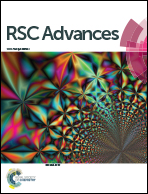Polyaniline–ionic liquid derived ordered mesoporous carbon nanocomposite: synthesis and supercapacitive behavior†
Abstract
A nanocomposite of polyaniline formed within ionic liquid derived ordered mesoporous carbon (PANi@IOMC) was prepared by polymerization of aniline in the presence of IOMC for electrochemical capacitors. The morphology and structure of the nanocomposite were investigated by scanning electron microscopy (SEM), transmission electron microscopy (TEM), Fourier transform infrared spectroscopy (FT-IR), and porosimetry. To fabricate the supercapacitor electrode, an appropriate mixture of the PANi@IOMC nanocomposite and activated carbon was sonicated in acetone, and then the resulting dispersion was coated on the carbon fiber paper using a spray-coating technique. Because of the relatively high surface area of the nanocomposite for faradaic redox reactions, a maximum specific capacitance of 542 F g−1 in addition to 85% specific capacitance retention after 1000 successive charge–discharge cycles were obtained. The excellent electrochemical performance of the nanocomposite compared to the pure PANi or IOMC, was attributed to the covalent bonding between PANi and the carbon structure in the presence of N-phenyl-p-phenylenediamine (NPP) as an initiator for linking the polymer chains to the surface. The results of the present work highlight the efficiency of the interfacial chemistry of NPP in generating the nanocomposite with enhanced conductivity and high surface area.


 Please wait while we load your content...
Please wait while we load your content...